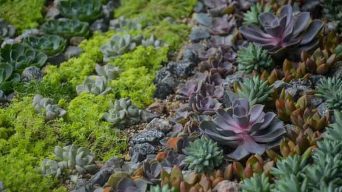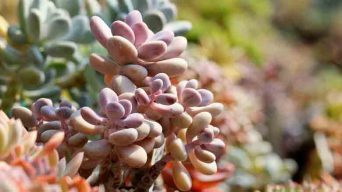When most people think of succulents, they imagine small, low-maintenance plants that don’t need much care.
While this is true, succulent plants can grow tall and provide plenty of color to any space!
This article will discuss 11 types of tall succulents so you can find the perfect one for your home, office, or garden.
11 Types of Tall Succulent Plants for Your Home or Garden
Succulents that grow tall are perfect for adding a vertical element to your home or garden. They not only bring a unique aesthetic but also thrive in various conditions.
Here are 11 types of tall succulents:
1. Adenium Obesum (Desert Rose)

The desert rose is a succulent that grows tall. It can grow to a height of 4 feet (1.2 m).
It has thick, fleshy leaves and flowers easily with stunning blooms ranging from pale pink to dark red.
This plant is characterized by a wide, fat base covered in spines. The tall columnar stem has large, rounded leaves and blooms with pink to red flowers followed by white or reddish-brown seed pods.
This plant does not need much sunlight and is perfect for people who want to grow succulents indoors without having them take up too much space on the floor.
Adenium obesum plants are also great outdoor succulents because of their drought tolerance.
To maintain this plant’s shape, you must repot it every two years since it tends to lose its upright form over time due to how fast it blooms when planted outdoors during summer months (starting at about mid-July).
The desert rose is found in the wild, mostly on rocky slopes and outcroppings, thriving in arid conditions.
2. Aeonium Arboreum

This succulent has slender, wiry stems that can grow up to a height of 3 feet (90cm).
The leaves are dark green with light green stripes, and the flowers are small clusters of white or pink stars in clumps in summer.
In winter, it produces large red berries which hang downward on long stalks from its branches.
This plant needs plenty of sun exposure, so it is best grown outdoors near doors and windows where they will get enough natural sunlight for its photosynthesis process to work effectively.
It also likes well-drained soil but cannot tolerate frosty weather conditions as temperatures below zero degrees Celsius will kill them off – do not plant these succulents outside if your area experiences cold winters!
3. Agave Americana (Century Plant)

Agave americana is also known as the Century Plant. They are considered tall succulents because they can grow up to 5 feet (1.5m) high!
These giant agave plants typically have long, narrow leaves and many small flowers that bloom in clusters atop an inflorescence stalk (stem).
This succulent sap contains sugar, making it popularly used for tequila production.
The agave plant does best when exposed to full sun or partial shade with well-drained potting soil during the growing season.
After blooming, it will go dormant if not provided enough water over time but will return next year after soaking up some moisture again.
This plant may be more prone than other types of succulents to rot from prolonged exposure to freezing temperatures, especially in regions with harsh winter conditions and low hardiness zones.
4. Austrocylindropuntia Subulata (Eve’s Needle)
The Austrocylindropuntia subulata succulent (also known as Eve’s needle) is a tall-growing cactus reaching heights of up to 13 feet (4m).
The plant has long, narrow leaves and spiky clusters at the ends. It bears wide pinkish flowers in the summertime.
This columnar type succulent prefers dry conditions but will survive temporary flooding.
5. Crassula Ovata (Jade Plant)

The Crassula Ovata is a tall succulent plant with small pink or white flowers and sprawling branches that often droop.
Its leaves have an oval shape, typically grow to around 12 inches (30 cm) long, and have a rough surface texture from the leaf ridges, making it perfect for hanging. It can grow up to 15 feet (5m) in height!
The Crassula ovata is commonly known as the “jade plant” because of its jade-like appearance and is often used in home decor.
It needs bright indirect light (preferably sunlight) to grow tall, so it should be placed near windows or outside on sunny days for optimum growth.
For succulents that don’t need lots of sun, you may place them less close to the window if they do not get enough natural light during daylight hours.
Proper growth of succulents requires adjusting their placement based on light conditions. Additionally, ensure faster growth by adding more water when the soil dries.
This plant grows quickly and makes an excellent houseplant choice.
6. Cyphostemma Juttae

The Cyphostemma Juttae succulent is native to South Africa. It can grow up to 6 feet (2m) tall and has a single, long stem with few leaves arranged in spirals.
The plant produces greenish-yellow flowers at the end of its branch throughout the summer months.
Its name comes from the Greek word “cyphes” for cup, and “stema”, which means stump or trunk.
This succulent is often used as an ornamental design element because it contrasts sharply against other plants due to its size and color scheme.
The Cyphostemma Juttae plant is perfect for areas with little water and high temperatures.
So, if you’re looking for an exotic plant that can withstand difficult living conditions, this may be your best bet.
7. Euphorbia Milii (Crown of Thorns)

The Euphorbia Milii is also known as the Crown of Thorns succulent cactus because it has long, sharp spines on its stems and fleshy leaves.
It can grow up to 6 feet (around 2 meters) in height, with branches or arms four inches wide at its base and eight inches long.
These cacti may produce red flowers but are small and not showy.
The Euphorbia Milii succulent is a low-maintenance plant. It needs very little water or sunlight to thrive, making it ideal for those in hot climates.
In cooler regions, where the weather can be more temperate, this plant likes light shade during summer.
This type of succulent grows tall enough that it will require some pruning to keep it in shape.
If you want to control its growth, cut the branches back to within one or two inches of a node – this will encourage new side branches and prevent the plant from getting too tall.
8. Kalanchoe Beharensis (Felt Bush, Elephant’s Ears)

Kalanchoe beharensis (also known as a Felt Bush or Elephant’s Ears) is a succulent that grows up to 16 feet (3.7m) tall.
These plants are native to the Kalahari Desert of South Africa, where they have adapted well with their tough leaves and spines.
The flowers are unusual- looking– like clusters of white bulbs on long stems.
They grow in late summer into fall, at which point they will turn brown and produce seeds from them before dying back again for the winter months.
This plant takes about four years to grow to its full height but can live up to 30 years!
9. Monadenium Magnificum

This plant is known for being tall and slender. It can grow up to 7 feet (2.1m) in height but also has a short form that grows more than one foot per year.
It has large leaves, which can grow up to two inches long and one inch wide.
The leaves are green or yellow in color, with purple spots on the edges of them.
It also produces pinkish-red flowers during the fall season from September to November every year.
Because of its size, this tall succulent plant must be grown outdoors with plenty of sunlight and space.
It’s a favorite among succulent collectors due to its rarity and ability to withstand harsh weather conditions.
10. Pachypodium Lamerei (Madagascar Palm)

This tall and slender succulent features a bushy, spiky crown that distinguishes it from neighboring plants.
As the succulent grows, its leaves extend into smaller branches, resulting in a distinctive appearance that sets it apart from nearby vegetation.
The long and narrow leaves often form branching points that give rise to spines, enhancing their visual appeal.
Despite its slow growth, this plant can reach an impressive height of 20 ft (6m).
Its reputation as an easy-to-grow plant is attributed to its minimal water requirements once established.
Additionally, it boasts a variety of colorations, including shades of green, pink, purple, brown, white, and yellow.
Madagascar Palms are tall growing succulents and make an excellent addition to any garden.
11. Sansevieria Trifasciata ‘Laurentii’ (Variegated Snake Plants)

Sansevieria trifasciata ‘Laurentii’ has a pattern of leaves with thick, green stripes on the edges that are accented by yellow in between them.
This succulent plant is tall and narrow, growing up to 4 feet (1.2m) high when planted outdoors.
It grows best as an indoor plant because it needs bright light for at least six hours or indirect sunlight all day.
These indoor succulents can be used as either ground coverings or potted houseplants, depending on their location within your home.
It will grow quite large if left unchecked indoors, but this also means you’ll need plenty of space!
These tall succulent plant types will grow into beautiful, lush plants with enough care and light!
It’s best to keep it where its height can be accommodated.
The Sansevieria trifasciata makes a great choice if you want something unique that requires minimal maintenance, like most other varieties of tall succulents on our list do!
Large Succulents for Pots to Grow Indoors
When it comes to tall succulents for pots, a few options can match the majesty of a succulent.
These strange and beautiful plants come in all shapes and sizes and are well-suited to life in a pot.
Many tall succulent plants can reach impressive heights, making them ideal for adding a touch of drama to your indoor space.
However, not all succulents are created equal. If you’re looking for a plant that will make a statement, choose one of the following tall varieties.
Echeveria Gigantea (Giant Hens and Chicks)
The first option is the Echeveria gigantea, which is native to Mexico.
This compact succulent grows up to 20 inches in height, producing gorgeous rosettes of green and blue leaves that grow up to a foot long.
The Echeveria gigantea is a relatively slow grower, so your plant will take some time to reach its full potential.
However, the wait will be well worth it when you see the end result.
Crassula Ovata ‘Tricolor’ (Variegated Jade Plant)
If you’re hoping for something more colorful, consider the Crassula ovata ‘tricolor.’
This South African native has variegated leaves striped with pink, white, and green.
The crassula ovata ‘tricolor’ can grow up to four feet tall, making it one of the tallest succulent plants available. Like most other succulents, this plant is slow-growing and drought-tolerant.
As long as you provide adequate plant care, ensuring it receives plenty of direct sunlight, it will thrive indoors.
Kalanchoe Tomentosa (Panda Plant)
The Kalanchoe tomentosa, also known as the panda plant, is a succulent that originates from Madagascar.
This plant is easily recognizable thanks to its furry, silver-grey leaves.
The Kalanchoe tomentosa can grow up to two feet tall and is relatively easy to care for.
This plant is a great choice for those new to succulent ownership, as it is tolerant of neglect and can withstand periods of drought.
Final Thoughts
Succulents are a great addition to any garden or home. They come in many shapes and sizes but require very little attention.
This makes succulents perfect for those who don’t have the time or resources to devote to caring for plants.
Growing tall succulents will add height to any succulent garden.
These plants also give an exotic feel with their unique shapes, colors, and textures.








